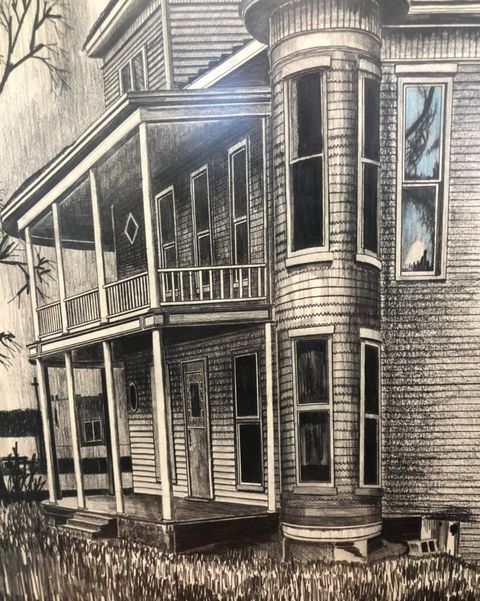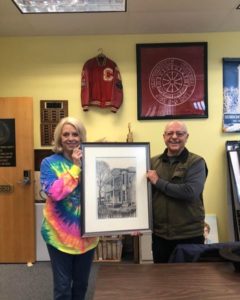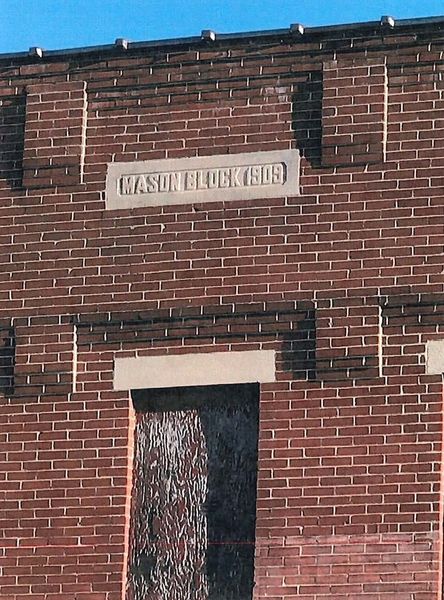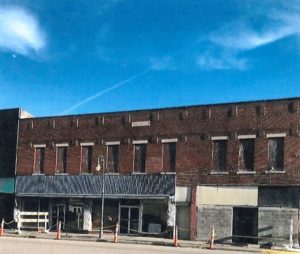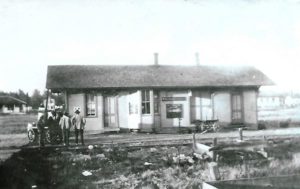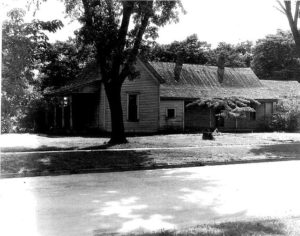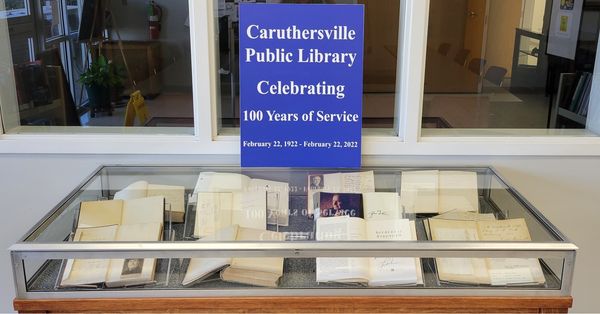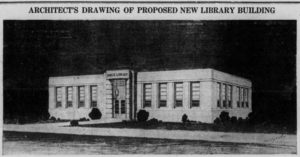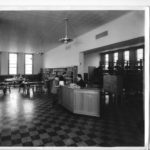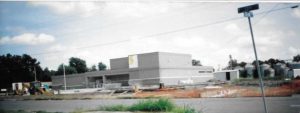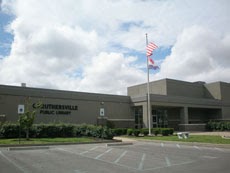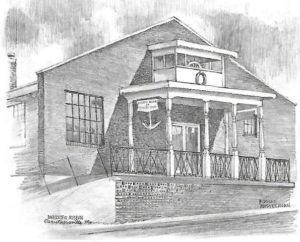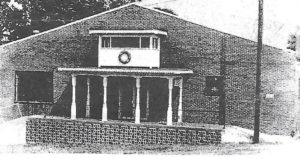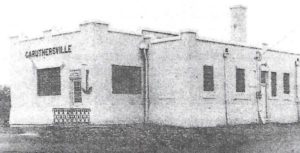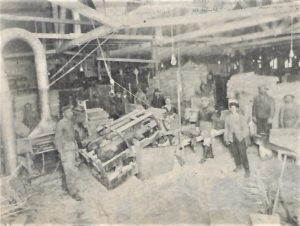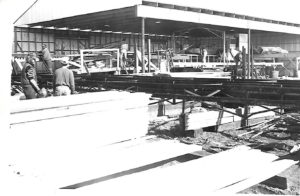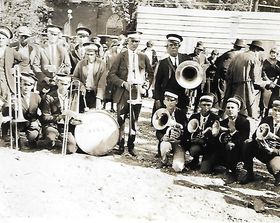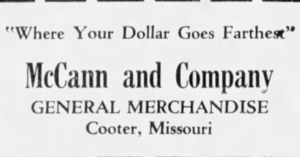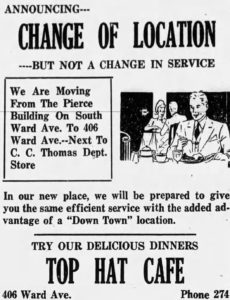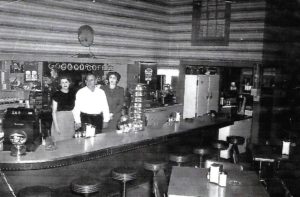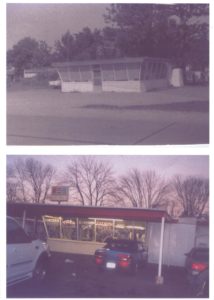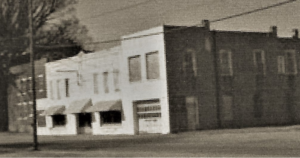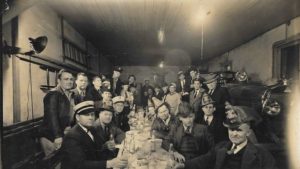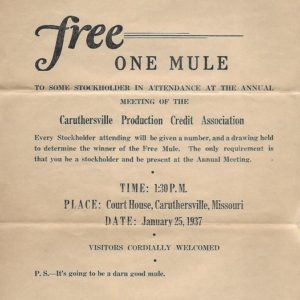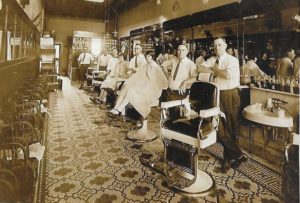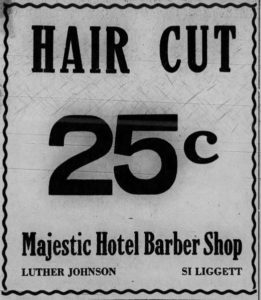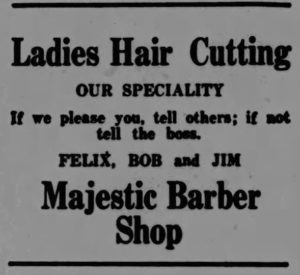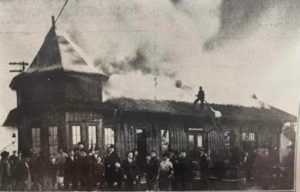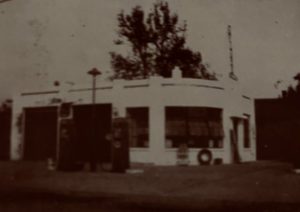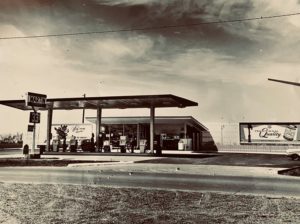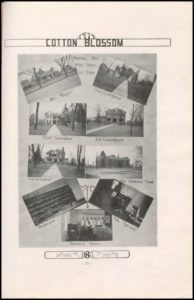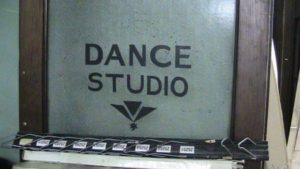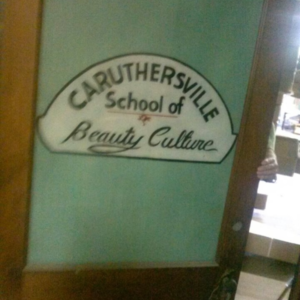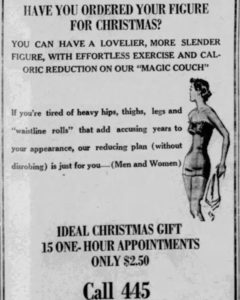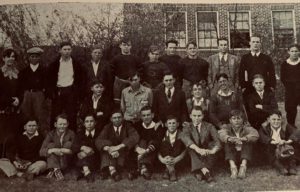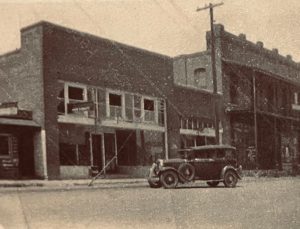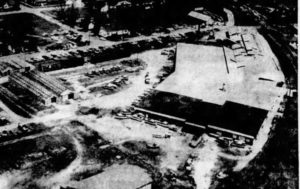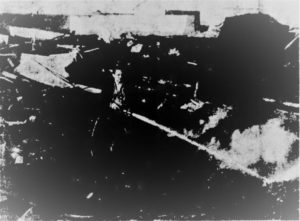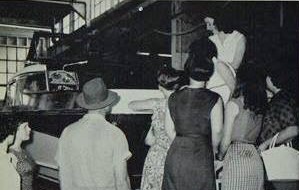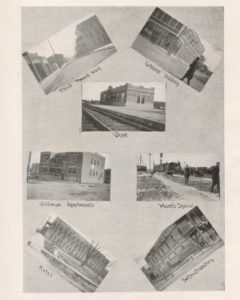Pictures from Facebook -2022
The Roberts Home was a large stately landmark very near the river, just across the sea wall in Caruthersville. Built in 1900 by a Mr. Zimmerman, it was said that Mrs. Sallie Roberts was able to see her husband, who purchased the home and was employed as a boat pilot, from one of the upstairs rooms. In the mid-1970s, a local group began to make preparations to have the home declared an historic landmark and it was planned for the venue to be used for weddings and other social events. Unfortunately the home burned in the Spring of 1977 and was a total loss. (The city’s maintenance shed now occupies the land the home sat on.) The historic preservation committee had been chaired by Mrs. Sue Swinger, and she and her husband, Dr. Terry Swinger, once looked at the home as a possible purchase.
Just this week, Dr. Swinger brought this pencil drawing of the old home to donate to the Pemiscot County Historical Society. Shown here Dr. Swinger presenting the art to Ms Phyllis McDowell of the PCHS. It is now on display behind the desk at the library for everyone to view. Much appreciation to Dr. Swinger for this artwork, as well as an original by Larry Adams, given to the library this week. Thank you!!
The Mason building in the Mason block of Ward Avenue was built in 1909, as is shown on the concrete label at the top of the building. For most of its life it housed the local Ben Franklin Store.
The May 7, 1948 issue of The Democrat-Argus had this to say about the Ben Franklin business:
“When Uncle Sam finished with William E. (Bill) Morris at the close of the ‘late unpleasantness’, he felt footloose and fancy free – somewhat at loose ends, in fact – and he wanted to work. He was back in ‘civvies’ and he wanted something worthwhile, something constructive to do. Deciding to look about a little, he made a visit here from his hometown in Illinois and he soon found what he was looking for. He like the town and its people – and he liked the sort of deal which Gordon Wright offered him on his Ten Cent Store. So he closed a deal with Mr. Wright (This was back in 1946) and not long afterward he brought his wife here from their former home – Jacksonville.
He decided upon a somewhat different system for his newly acquired business, so early in 1947, he secured a larger building across Ward Avenue from the original site, had it remodeled and refurbished and turned into a place suitable for conducting a store allied with the Ben Franklin system. The latest type of display cases, merchandise racks and shelving, etc. were installed, and almost all new merchandise was stocked, so that today one can scarcely find a more complete, comprehensive or well-stocked ‘Five and Ten’ anywhere, in any community, even with many times the population of Caruthersville.
Mr. Morris did not enter the variety store business wholly as a novice, however. For several years prior to his army experience, he had made a study of the wants and needs of patrons of this class of store and this, coupled with keen business acumen, has made the local Ben Franklin a very popular and a thrifty place for people for miles and miles around to shop.
In any community, good stores with well-stocked shelves of items people need and want, constitute one of the greatest drawing cards – and a ‘five and ten’ stands close to the head of the list in customer appeal. Such a store indeed is Bill Morris’ Ben Franklin store. Its wide variety of merchandise, its extreme neatness, the care and courtesy of well-trained sales personnel, all appeal to the average individual – hence, this store is part and parcel with a long list of reasons why you will do well to shop in Caruthersville.”
Mr. Morris continued to operate the Ben Franklin store in the same location until around 1977. Shown in the second picture is a photo from the 1965 Cotton Blossom yearbook with Linwood Betz, Linda Connor (Stetson), Sally Morris (Fisher) and Wayne Speight in front of the store in its glory days. The final picture shows the building as it appears in early 2022, with the Mason Block 1909 still easily visible at the top.
The Deering Southwest Railroad – from the Twice-a-Week Democrat, February 3, 1911
“At a few minutes to 6 o’clock on last Tuesday afternoon, Judge H. C. Garrett, mayor of the city, and S. P. Reynolds drove the golden spike closing the gap in the Deering Southwest Railroad, thus giving us direct rail connection with Braggadocio and Deering, MO.
Just at dusk, the headlight of the engine was seen at the fairgrounds approaching and was greeted with shouts by the several hundred who had waitied patiently despite the damp ground and disagreeable weather. As the train approached and halted, a huge bonfire was built and then began the ceremony of closing the gap.”
The International Harvester-controlled Wisconsin Lumber Company incorporated the DSW on June 24, 1903, with the first tracks from the mill at Deering to Hickory laid that year; the rest of the road was completed in 1910 and 1911. Logging rapidly dropped off after 1925 and, as fast as the forest was cleared, cotton was planted, destined for market at Memphis.
Shown below is the depot at Deering and one of the trains at the stop.
Around 1900, Henry Clay Garrett’s livery stable at Third Street (then called George Street) and Walker Avenue was a very busy location. In 1908, there were at least three livery stables downtown in Caruthersville.
Streets at that time were named after important figures in the establishment of the city: Hardeman, Charles, James, George, Cunningham, Billingsley and Wilks – but later were changed to Jupiter, Mars, Mercury and other planets, but later settled into the numbered cross streets we still have.
Caruthersville Public Library will be celebrating it’s 100th Birthday on February 18th. For #tbt in February, we will be looking back to interesting facts you may or may not know about the oldest library in the area – Cape Girardeau is just a few months younger, turning 100 on June 15th this year.
When the Caruthersville Women’s Club established a “county reading room” in the city, it first was in the “clubhouse” of the group at the corner of Sixth Street and Walker Avenue, where bookshelves were built in the balcony. Each member was assessed $1.00 for expenses and they canvassed the four wards of the city and received many more donations. The Educational Department of the Women’s Club held a “Book Shower and Tea” the week before the library opened and enthusiasm was aroused for the new addition to the city.
On April 3, 1923, a vote to have a one mill tax for the purpose of supporting the library was on the ballot and received a favorable vote. Miss Zula Stephens was hired as the first librarian.
The very first Library Board was Mrs. Frank Dillman, Mrs. S. P. Reynolds, Mrs. R. L. Ward, Mrs. T. H. Warden, Mrs. W. H. Johnson, Mr. Charles Ross, and Mrs. Hugh A. Tistadt. When the organization was formed and perfected, the library became an independent organization.
They soon relocated to the Lacey Building on West Fourth Street, but in 1925, J. H. Elder purchased the building for a soda fountain and confectionary. The library was forced to box up its books and wait to secure another building. By 1925, the George Rogers homestead at 1000 Ward Avenue was available to become the public library. It served in this capacity until 1940.
Pictured here is that first library to have the official name of Caruthersville Public Library. This particular homeplace is still visible from Carleton Avenue on the south side of West 10th Street.
Continuing our walk through the history of Caruthersville Public Library, we move to a collection we host that very few are aware of – the Presidents’ books.
Located inside our lobby in the glass display case, volumes of antiquity actually autographed by former presidents of the United Statesare housed. Books autographed by Benjamin Harrison, Franklin D. Roosevelt, Herbert Hoover, Calvin Coolidge, Warren G. Harding, Woodrow Wilson, Theodore Roosevelt, and Harry Truman are displayed, as well as later books from George Bush, George W. Bush, and Jimmy Carter. There is also a book autographed by William Jennings Bryan.
First librarian, Mrs. Zula Stephen Folwkes actually wrote to these presidents directly in the 1920s and 1930s, asking them to donate and autograph books that were special to them. (Harry Truman was a special friend of Caruthersville in the late 1940s and early 1950s and Wiley Patterson, member of the Pemiscot County Historical Society, gave us the more recent volumes.)
In the July 6, 1934 issue of the Democrat-Argus, Mary Lord Harrison, the wife of Benjamin Harrison, wrote to Mrs. Fowlkes and thanked her “for the privilege of donating to the unusual collection for your local library. There probably is not another such collection to be found in the United States.”
Mrs. Fowlkes, librarian, said that “These gifts have been highly appreciated and, though they may not be borrowed from the library, they may be seen upon request. As the years go by, the value of the books will grow.”
It was later quoted in another issue of the newspaper: “Even though the public library is small and young, it is worthy of belonging to a much larger city and has treasures in the little frame dwelling far too priceless to risk much longer where fire could destroy in so short a time and could never be replaced.” In just a few years, a new library was built in the place of the frame house at Tenth and Ward Avenue.
These autographed books can be viewed anytime in the front lobby of the library. We feel very privileged to have them.
On July 6, 1938, voters in Caruthersville approved a $15,000 bond for construction to build each a new armory and a new public library as a part of the WPA projects taking place during this era. On October 10 of that year, the City Council authorized the sale of the $30,000 in bonds to Harry Litzelfelner.
Construction soon began on Caruthersville Public Library at Ward Avenue and 10th Street after moving the first library off of the lot. During 1939, there were visits to other libraries, including Kennett, by Library Board members, Mrs. Hugh Tistadt, Mr. Ralph Pinion, and Attorney Fred Henley to explore their layouts and finishes. Librarian Mrs. Donald V. McGee began planning the move from the “archaic” house that it moved into in the early 1920s and helped the architect prepare the library’s new home.
On April 17, 1940 at 7:30 p.m., the new Caruthersville Public Library was introduced to the community with its proud “Public Library” over the front doors (Still visible today, even though it now houses the city court building). School children were brought to the library throughout the next day to tour the new facility. “Its 8000 volumes place it among rural Missouri’s largest libraries” reported the April 23, 1940 issue of the Democrat-Argus newspaper.
Governor Lloyd C. Stark made a visit to Caruthersville and toured the new facility on June 26, 1940 and was able to meet the Library Commission and patrons of the library. He gave a speech at that time, commending the community for construction of the beautiful new building as a gift for its citizens.
Shown here are a picture of the architect’s drawing of the library, a photo during the 1938-1939 construction process, and a picture of the interior of the library soon after it opened, which many of us remember from our younger days.
After the Ward Avenue library opened in 1940, roof leaks became a constant problem and worry. As time went on and computers and the internet came onto the scene, that large 1940s library suddenly became very small. Additions to the collection over the years (in 1963, Mayor B.F. “Hot” Rogers even gave his entire salary to the library to purchase library books), overcrowding of the collection became a concern.
During the 1990s, the Library Board, headed by Mrs. Martha Stevens, and Mayor Diane Sayre began to consider ways to expand the library. Discussion even took place on enlarging the library across the alley in the middle of the Tenth Street block, but supervision of the entire space would have been difficult. Thought was even given about purchasing the homes in the back of the library to make it bigger, but the prices were out of the library’s range.
The land where the old Brown Shoe Building was located on West 13th Street was owned by the city and Mayor Sayre began to think of how the library would have room to expand and grow and how centrally located the space would be. Plans were made to construct a brand new building, ready for the “computer age” and the city received the former library building on Ward for the price of $1.00 in exchange for the property on 13th. It is now the City of Caruthersville Court Building.
This building, which opened on February 17, 2002, is the beautiful setting that the library is still enjoying. The backyard, with its John VanAusdall Reading Pavilion and the fish pond, as well as the Kay Norton Gill Genealogy Room, the Baxter Southern Auditorium, and the Pemiscot County Historical Society room are all within the scope of Caruthersville Public Library now.
Digitization of our past (newspapers, books, historic papers and photos) have become the way for the library to reach more patrons and to improve our outreach. Computers have led to laptops, iPads, and Chromebooks, as well as smart TVs, which were not even thought of in 2002 when the new building came into being.
As we reached our 100th birthday last Friday, we will continue to be a community hub, the “lifelong learning center of Pemiscot County”, a vital part of life in Caruthersville and Pemiscot County.
In 1946, a new establishment for Caruthersville – a jewelry and gift shop, along with a jewelry repair business – was opened in a somewhat unusual ownership combination, a brother and sister. The proprietors were Noel Quinn and his sister, Miss Betty June Quinn, and their place was located in the “rapidly developing business center on South Ward’ – 1308 Ward Avenue. (This is the block where the city’s police and fire departments are now located.)
Under their arrangement, Miss Betty did the buying and Noel did watch, clock and jewelry repairs while also “waiting on the trade” as his time permits.
Both of these young people were born and raised in Caruthersville and Mr. Quinn added a “third member” to the firm when he was married to Miss Virginia Whitfield a few weeks ago.
After his graduation from high school, Noel learned the barber trade and worked about four years with his father, A.L. Quinn, in his shop nearby their present store. However, he had been “tinkering” with watches and clocks since he was a small boy – and liked it – so he decided upon a change. In 1945 he attended a jewelers’ school to further fit him for his chosen vocation and soon after his return, set up the business in his own modern fireproof building, constructed especially for this type of business.
“When young people who have lived in a certain community all their lives see and realize its future business potentialities and seek to work in earnest to become part and parcel with its future activities, it augers well for that city or community and encourages others to do likewise. It is one of the things which makes Caruthersville the desirable place it is in which to live and earn one’s living” as reported in the August 13, 1948 issue of the Democrat-Argus, from which much of this information was adapted.
The Riverview Museum in Caruthersville is pictured here in both a photograph and a pencil drawing by Roscoe Misslehorn (given to the Historical Society recently by Mrs. Delila Sayre).
According to Barbara Lane Meales in the Fall, 2020 Pemiscot County Historical Society quarterly, as far back as 1961, the Reynolds Park Association announced that the old brick warehouse property would be torn down. She discovered that this warehouse was built around 1925 for a wholesale warehouse.
It was suggested that this might be used for a museum to house some of the interesting history and items used by the early settlers of the county.
Many residents contributed items for display and it opened in October of 1969. However, it was difficult to heat this building and air condition it to preserve the artifacts, so in 1979, the museum opened in the old Frisco depot building on West Third Street. (Construction took place on it between October 1914 and May 1915, when the depot opened for business.)
Sue Swinger served as chairman of the museum committee. However, because of a lack of volunteers to keep the museum open, it was not opened after 1986 and the building had dilapidated since then. Many artifacts were damaged by temperature extremes and humidity. Some Indian skeleton that were among the artifacts in the building were returned to their tribes for burial after a 1991 law was passed requiring this.
Engineers presented a report on renovating the building but the cost would be exorbitant. Their opinion was that the building wasn’t worth the expense of saving it. In January of 1995, the old Frisco Railroad Depot was demolished.
The oldest continuous industry for many years in Caruthersville was the Betz-Tipton Veneer Company, which operated in the same location as the Dillman Egg Case Company, which was started in March of 1906 by Frank and Arl J. Dillman. The principal products made at that time were rough lumber and wooden egg cases, but many other containers were designed and produced by the Dillmans.
Mr. Dillman ceased operation during a time of apprarent prosperity because he refused to have a union at the plant. The union had organized the plant and had struck just before Thanksgiving in 1941. The company closed its doors and ceased operations and Mr. Dillman sold the plant to other interests.
The veneer mill and sawmill, along with the lumber yards and various properties connected with them, were sold to a group of interested persons. The initials of these men were used to make up the name “HOBAC”, denoting in order Holcomb (HO), Bratton (B), Ahern (A) and Conkling (C). James T. Ahern, then the general manager for Dillman, became the managing partner of the new concern.
HOBAC began operations in 1942 and continued much along the same lines as Dillman. In 1952, upon the death of Mr. Holcomb, the other partners decided to sell to a partnership of Joe Tipton and Bill Betz.
Betz-Tipton Veneer Company began operations officially in December of 1952.
The company’s first order began as a bailed wooden box operation and its first order was a large contract for mortar shell boxes for the government. Because of the lack of time to erect a suitable building in Caruthersville or to find a suitable building here, in order to meet the contract deadline, operations were begun in the old shoe factory building in Steele.
On the completion of this order, which lasted for several months during World War II, the plant converted to the manufacture of wirebound wooden boxes. The company had national markets and helped Caruthersville, at that time, to be known as a woodworking center.
Though the stay in Steele was supposed to be temporary, the company remained there for eight years. It was decided to combine the Steele and Caruthersville plants.
In the 1990s after riverboat gaming was approved in Missouri, several interested companies felt that the Tipton property would be the best location for the casino. The family sold the property and dissolved the business at that time. Today, Century Casino occupies the land.
(Someone called the library just last week, looking for pictures of the Dillman Egg Crate company, but we had none at that time. Thanks to the Jeanine Teroy and her daughter Briana Sprunger, they presented us and the Historical Society with a number of old pictures, which included these two shots of the box factory. The first one was taken in the late 1910s or early 1920s and the second is more recent from the early 1970s.)
The Cottonwood Point Brass Band, composed of twenty-five instruments, was composed of young men and boys from the Cottonwood Point neighborhood, and “each a musical artist”. One little fellow, about ten or twelve years of age, was a wonder on the cornet, it was reported at that time. Some of the older citizens in the mid-1920s said that it was the best band ever organized in Pemiscot County. It was under the leadership of Mark Denham of Caruthersville.
One notable appearance by the band was on National Defense Day, September 12, 1924. They led the parade and marched over the route selected – north from the Methodist Church to Third Street, west to Carleton, south to Sixth, and then to the fair ground. Commanding officers of the military units, along with the Boy Scouts, a Red Cross Corps, and the members of the Rotary and Lions Clubs. An interesting occurrence on this day was a “one day only” registration of citizens for service, carried out by the members of the military units. Between 300 between the ages of 18 and 45 were enrolled. This brought the strength of the local units up to and beyond their full war time strength and the served the purpose of this portion of Defense Day activities admirably.
It was reported that the “ambitious little orchestra rendered good account of itself, the music they played being enjoyed alike by people and visitors”.
By May of 1925, Mark Denham became the supervisor of a band organized by the Caruthersville Rotary Club. The band was composed of 22 members, all beginners, ranging in age from 7 to 18 years. It was all “home talent, with the exception of a few boys from Cottonwood Point”.
The McCann and Company Store, located in Cooter, was owned and operated by Elvis and Opal McCann. The post office was in the store building and Opal McCann, who was also the reporter for a group of ladies called “The Cooter Club” in 1933, served as the postmaster. The store and post office were destroyed by an arson fire in 1935. This picture was taken in 1940 and the advertisement below was from the Steele Enterprise on November 19, 1931.
The Top Hat Cafe was a landmark in Caruthersville, operating for many years, first at 1111 Ward Avenue, next to the first Peck Hayden drug store (the old Tiger Hut), then at 406 Ward, and finally on West 3rd Street in the building next to the Majestic Hotel that later became Hinchey’s billiard parlor. The “Mona Lee Room” named after one of the owners, was a constant location for showers, meetings, Bridge clubs, and parties.
These pictures of the restaurant are from the 1940s, when the restaurant was at 406 Ward. Shown behind the soda fountain are the Aimsworth family, Shirley, Roy and Mona, the family team of owners.
Roy and Mona later opened the “City Pig” Restaurant on East 5th Street, where Lux & Luv is located today.
Something that many people in Caruthersville remember but don’t often see is a picture of the “slab-making yard”, known as the “Slab yard”. Here it is in its later days, with slabs of reinforced concrete piled on the ground by the river, next to where the old Powell’s Ferry landing was located.
In 1931, largely through efforts by S. P. Reynolds, engineer for the St. Francis Levee District, a government plant would be constructed for manufacturing concrete slabs to be used in revetment of the riverbanks between Gayoso Bend and the end of Island 18 near Cottonwood Point.
It employed a good number of men for many years, but later fell into disuse. The Caruthersville Chamber of Commerce in December of 1966 sought to revitalize the slab yard; then the Corps of Engineers stepped in with an announcement that the spring of 1967 would have it back in business with a new contract for 36,000 square of concrete mattresses.
The slab yard was closed permanently in the late 1970s.
From April 18, 1927, this is a clear-as-a-bell photograph of downtown Caruthersville, looking south from Third and Ward.
December 29, 1899, a “portable photo gallery” was in the city to take portraits for residents, but they were warned that it wouldn’t be here long. In 1901, a man named Evans purchased a studio and his slogan was “Evans Gallery is strictly “it”. That is why all the others have quit”. F. M. Gerdon, a photographer from Malden who heroically thwarted a bank robbery in that city, came to our town to open a photography studio.
The premier photographer in Caruthersville for over 30 years, though, was J. J. Gallian with his high quality pictures. He took over the Brown Studio in 1917 and continued in business until 1947, when brothers R. L. and Byron Ward purchased Gallian’s business at 510 Ward and conducted business as the Ward Studio until the mid-20th century. In more recent years, Mike Dale built a photography studio at 1409 Ward and operated a business there for many years.
With advances in personal cameras, and later cameras on personal phones, photography studios have become very rare; however, these glimpses into what our city was like in the “olden days” are a treasure given to us by these pioneer photographers.
In the early 1940s, Knox Figgins opened an ice cream parlor between Third Street and the seawall. He moved the business to Laurant Avenue before locating an ice cream parlor, snack bar, and wholesale ice cream business on Grand Avenue in the late 1940s.
The Knox’s Drive-In pictured here was built about 1957, after listing the property for sale with plans to retire to the Ozarks. However, when the former Juliet Street was developed into the Fair Blvd bypass (later Truman) and property values increased, he changed his mind about moving and opened the landmark Caruthersville business.
In the late 1950s or early 1960s, the business expanded. The interior was enlarged to include inside service and an indoor dining area. What had previously been the outside counter became the center of the new serving area. A year or so later, the carport awning was added and on April 1, 1963, John Figgins and Denver Meek, son and son-in-law of Denver, took over the business. After Knox retired, however, he wanted something else to do. He had previously purchased two lots behind Knox’s and built a miniature golf course on this property. The course stayed open a couple of years and then closed; at that time Knox completely retired and moved to Florida.
One of the unique features of Knox’s was their credit agreement with parents for their kids’ food and treats. Some kids would have standing orders for lunch when school was in session or stop by anytime to get something to eat or drink. It was an honor system. The kids were not required to sign any charge tickets. A statement was mailed to the parents monthly. Once a young reporter from Channel 5 in Memphis was in town following up on a story. She and her cameraman stopped by Knox’s on their way out of town. School had just been dismissed for the day and lots of kids were getting their treats. The reporter went back into the kitchen and asked Denver if he was aware that kids were getting merchandise at the counter and not paying for it. He explained what was happening and explained that they parents would pay for it later. The reporter had never seen or heard of anything like that and did a feature on Knox’s that night on Channel 5 news.
When John retired, Denver’s son Kevin purchased John’s share of the business, but at the end of five years, in May of 1997, he sold his interest to Chris Cummings and at the end of 1999, Denver retired and sold his interest to Chris, ending the family’s ownership in Knox’s Drive-In.
In April of 2006, the business was destroyed by the F3 tornado that struck Caruthersville.
Around 2016, Knox’s was opened again further north on Truman, but sadly closed again.
(Information for this article came from John Figgins, Jr. and Barbara Meales in the Pemiscot County Historical Society quarterly.)
The Menzies Shoe Company was the original owner of what we all remember as Brown Shoe, constructing this building in 1927 with local citizens furnishing the money by purchasing lots on the site at an inflated value. Despite promises from the Menzies people to provide many jobs to Caruthersville workers, it operated only a few months with almost no production and with very few employees. For many years, it appeared to be little more than a “white elephant” on Caruthersville’s hands.
The Building was returned by the Menzies Company to the Shoe Factory committee, which brought the Menzies Company here originally, and it was later taken over by the Ely-Walker Dry Goods company, who kept it without operation for over two years before returning it, together with an $8000 bonus received with the structure to the committee.
The members of the committee made up of H. V. Litzelfelner, W. B. Bernard, Arl J. Dillman, N. W. Helm, J.S. Wahl and other local businessmen, kept the building insured and in good repair, maintaining a watchman and a caretaker. Frequently, public functions such as dances and carnivals were held in the building.
In 1934, a chance news item in the Memphis newspaper gave J.S. Wahl, a member of the local Shoe Factory committee, a clue which brought local contact with the Brown Shoe Company and led to a deal on a branch plant being located here.
From this time, the Brown Shoe Company came to Caruthersville and was a successful factory for several generations of families. It became the largest employer in the city and operated for 60 years, closing in March of 1994, causing unemployment to soar to near 20 percent. About 400 jobs were lost.
This building on West 4th Street in Caruthersville that formerly housed Dillman Auto Parts was also the home to the Caruthersville Fire Department for many years.
Referred to as the “fire barn”, the building was torn down in early 2008 but had been the station for over 40 years. The rooms upstairs were rented out to citizens at various times when no driver was employed and the various members of the department took turns acting as driver of the fire engine. In 1942, the Chamber of Commerce began holding its meetings there.
The Fire Department moved into a new modern and larger one-story building on East Seventh Street in 1957, and now is housed in an even more modern and up-to-date building in the 1400 block of Ward Avenue.
With a view of the old Stutz engine on the right of this photo, the Fire Department hosted the City Council at the station around 1937. From left to right in the front row are Clem Hill, Glen Vandivort, Howard Sparks, Charlie Hill is behind Sparks, John Nelson on the right of the table, Obie Coker, Gordon Wright, Wyman Dillman, and Mayor Dayton Pinion. Standing from left to right are Bob Mick, George Watkins, “Red” Green, “Pidge” Watkins above the crowd, Glen Blackwell, and the next two are unidentified. Center, rear, is Vic Malloure, Senator Burrus is in front of Vic, Dick Lewis, “Doc” Davis, McCurry Meyers, Sr., George King, unidentified, Hugh England, and H. Edwards.
Quite a come-on for stockholders to attend the annual PCA meeting in 1937.
The P.S. on this is priceless!
Originally built in March of 1914, The Majestic Barber Shop was located in the lobby of the Majestic Hotel on Third Street. It is interesting to see in this photo that two young ladies occupy the chairs in this traditional “man’s world”, although as early as 1921 a manicure parlor was opened in the shop. As shown in one of the ads here, “Ladies Hair Cutting Our Specialty – If we please you, tell others; if we don’t, tell the boss.”
Two of the most well-known barbers in Caruthersville, Luther Johnson and Si Liggett, once ran the Majestic Barber Shop. Liggett finished his career in a shop with his name on Ward Avenue near the location of Prescription Drug Store today.
The first Hayti Depot was destroyed by fire on February 22, 1911. According to the February 23 issue of the Pemiscot Argus, a fire broke out in the Frank Williams’ restaurant near the depot just after the afternoon train had passed south and the flames spread to the Depot restaurant adjoining it, thence to the depot building itself. The three buildings were completely destroyed, but willing hands worked faithfully and managed to save about everything in the depot. The fire is supposed to have started from a gasoline stove in the restaurant. This is quite a blow to Hayti, the newspaper went on to say.
Another more modern depot replaced it, opening in 1913.
Recognized as one of the best-equipped and most efficiently operated service stations between Memphis and St. Louis, the E. Powell Service Station, located at 4th Street and Highway 84 in Hayti was a relatively new acquisition to the commercial life of Hayti in 1938, when this picture was taken. This station was said to be provided with every up-to-the-minute convenience to be found in the best of service stations in large cities. Mr Powell, the proprietor, had been connected with the sale of petroleum products in Hayti for a number of years and was one of the best-known citizens of the county. Mr. Powell was lauded for his public spirit and unbounded faith in the future of Hayti, which moved him to take part in all enterprises for community progress in Hayti during the late 1930s and 1940s.
With gas prices at an all-time high, today’s blast from the past is a photo of the Martin Oil Company station which was located at the corner of Fair Boulevard (now Truman) and Highway 84, where Jiffy Jim’s is now located. To add insult to injury, the price of gas at that time in the late 1960s was 33.9 cents a gallon.
Today’s “throwback” is a page from the very first Cotton Blossom yearbook in 1917, showing several landmarks in the city. They are labeled, but are difficult to read. The page reads “Homes and Other Scenes in C’ville”. Upper left is a home labeled “Mrs. Rogers”; On the right is another home labeled “Charles Cunningham”; In the second row are homes labeled “Clint Cunningham” and “J. A. Cunningham”; The next row features a home labeled “T. J. Cunningham” and “Grammar School”. The lower three pictures are scenes around Caruthersville High School. From left, “The Stack Room”, where it appeared that textbooks were stored and “The Tannery”, which was the office where students were sometimes paddled. Finally, the bottom photo shows the “Domestic Science” class, a forerunner of Home Economics and Family and Consumer Science, as it is called today.
The building known as the Exchange Building at 3rd and Ward Avenue once housed a number of offices and businesses on its second floor. The names of some of them are still etched on the doors up there – two of them being the Caruthersville School of Beauty Culture and the Jo Bay Dance Studio.
The Caruthersville School of Beauty Culture first opened in early 1948 and operated in the “New Teroy Building” at 108 W. 5th Street, when Mrs. Dalton Teroy accepted applications for a state approved school. In 1949, the school moved to the “Gossom Building”, now the Exchange Building at 113 W. 3rd Street. There is no information about when the business closed.
Each year in September starting in the late 1950s, advertisements were posted for sign-ups for dance classes for the coming year. These featured children’s classes for ballet, toe, tap, and ballroom dancing and adult classes for ballroom, jitterbug, waltz, fox trot, samba, rhumba, and tango. Children age three and up were accepted in the school. It was called the Jo Bay Dance Studio and was popular for classes, as well as offering a venue for parties. Later, the Slim and Trim Salon became a popular location. Opening in November of 1957, they gave free demonstrations of their “magic” and gave a free course to the heaviest woman visiting the salon during the ground opening.
On the day after Christmas in 1959, a fire broke out in the second story of the building, but thanks to quick discovery the damage was mainly from smoke and water. The Dance Studio, nor the Slim and Trim Salon, were not mentioned again after this time.
Built by Denny Mitchell in 1937, Gobler Mercantile Company was a thriving business. The slogan that it was known for is “We handle everything” and they did handle almost everything too and farm-related. It remained until 1956 when it was destroyed by fire. Mitchell opened another business at that time called the Denny Mitchell Grocery in the Gerald Burke building in Gobler.
Caruthersville had a Junior College on the upper floor of the high school building in the early 1930s. This photograph of the “Bachelor’s Club” from the 1930 “Pilot”, CJC’s yearbook, said “As the name implies, these boys are not eager to enter the sea of matrimony – their primary aim is to become acquainted with facts about Home Economics. Officers of the club were President – Edwin Jackson, Vice-president – Irvin Cunningham, Secretary-Treasurer – Earl Long, and the spon…
See more
In 1910, John R. Kelley built the two-story brick building and two adjoining buildings that were torn down to make room for the Sam F. Hamra Community Center in Steele.
One of the two-story buildings was used for a retail establishment downstairs and a hotel upstairs – the New Commercial Hotel as it was called at one point in history and it was sold to Fannie Green by Mrs. Lawhorn in 1924. Dr. T. A. Michie also had offices there in 1924.
The building on the left, which formerly housed the Steele Enterprise, shows the residents at the time of this picture to be Moore and Kelley Real Estate, J. I Southern, and Roy W. Harper, Attorney at Law.
Chris Craft, a manufacturer of luxury pleasure boats, had a factory in Caruthersville from 1946 until 1960. It was located on the riverfront, near the HOBAC company (Betz-Tipton), where the casino property is located today.
Chris Craft never hired as many employees as they originally forecast, blaming supply issues needed for the boat construction. A devastating fire in one of their buildings in 1953 brought more problems. (William Reel is shown spraying water on the still burning embers of the fire.) This particular building held much of their building materials, as well as a dozen boat “kits” ready to ship, causing a huge dollar loss from the fire.
The Delivery building itself shown here in the top photo was 500 feet long and about half as wide. The final photo here shows students from the American Problems class at CHS touring the factory in the mid-1950s
In the late 1950s, union formation began commanding attention. a strike at the Michigan plant again caused supply issues, bringing the Caruthersville to a near halt in 1958. Then organizers enlisted employees to strike for better wages in early 1960. The plant shut down completely for several months and never really recovered, closing in mid-1960.
These photos of Caruthersville and various sites around the city come from the 1917 Cotton Blossom yearbook. Under each photo we have (upper left) “Third toward Ward”; (upper right) “Exchange Building”; (Center) “Depot”; Middle Left “Dillman Apartments”; Middle Right “Ham’s Special”; Bottom Left “Hotel”; and Bottom Right “Self-explanatory” (J.S. Wahl Bottling Works at 3rd and Carleton)
The Pemiscot County Historical Society welcomes any donations you may have of classic pictures, yearbooks or other historic artifacts. Just drop them by Caruthersville Public Library and they will deliver them to the H.S. Room in the building.
